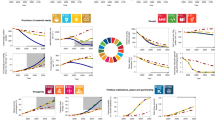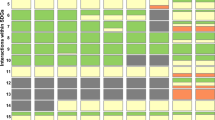Abstract
The post-2015 development agenda is dominated by a set of Sustainable Development Goals (SDGs) that arose from the 2012 Rio+20 United Nations Conference on Sustainable Development. The 17 goals and 169 targets address diverse and intersecting aspects of human and environmental needs and challenges. Achieving the SDGs by 2030 requires implementing coordinated and concerted strategies and actions that minimize potential trade-offs and conflicts and maximize synergies to contribute to multiple SDGs. Measures to mitigate emissions of short-lived climate pollutants are an example of actions that contribute to multiple outcomes relevant to development. This Perspective highlights the interlinkages between these pollutants and the SDGs, and shows that implementing emissions reduction measures can contribute to achieving many of the SDGs.
This is a preview of subscription content, access via your institution
Access options
Access Nature and 54 other Nature Portfolio journals
Get Nature+, our best-value online-access subscription
$29.99 / 30 days
cancel any time
Subscribe to this journal
Receive 12 print issues and online access
$209.00 per year
only $17.42 per issue
Buy this article
- Purchase on Springer Link
- Instant access to full article PDF
Prices may be subject to local taxes which are calculated during checkout

Similar content being viewed by others
Change history
22 February 2018
In the version of this Perspective originally published, Fig. 1 incorrectly had two entries of ‘Reduced rate of sea-level rise by 20% by 2050’; the first entry (row 2, column 3) should instead have read ‘Reduced disruption of weather patterns’. This has now been corrected in the online versions of the Perspective.
References
Rogelj, J. et al. Energy system transformations for limiting end-of-century warming to below 1.5 °C. Nat. Clim. Change 5, 519–527 (2015).
Shindell, D. T. et al. A climate policy pathway for near- and long-term benefits. Science 356, 493–494 (2017).
Xu, Y. & Ramanathan, V. Well below 2 °C: Mitigation strategies for avoiding dangerous to catastrophic climate changes. Proc. Natl Acad. Sci. USA 114, 10315–10323 (2017).
Integrated Assessment of Black Carbon and Tropospheric Ozone (UNEP, Nairobi, WMO, Geneva, 2011).
Shindell, D. et al. Simultaneously mitigating near-term climate change and improving human health and food security. Science 335, 183–189 (2012).
Xu, Y., Zaelke, D., Velders, G. J. M. & Ramanathan, V. The role of HFCs in mitigating 21st century climate change. Atmos. Chem. Phys. 13, 6083–6089 (2013).
Carvalho, S., Andersen, S. O., Brack, D., & Sherman, N. J. Alternative to High-GWP Hydrofluorocarbons (Institute for Governance & Sustainable Development, 2015).
Lam, N. L. et al. Household light makes global heat: high black carbon emissions from kerosene wick lamps. Environ. Sci. Technol. 46, 13531–13538 (2012).
Reducing Global Health Risks through Mitigation of Short-Lived Climate Pollutants (CCAC, Paris, WHO, Geneva, 2015).
AMAP Assessment 2015: Black Carbon and Ozone as Arctic Climate Forcers (AMAP, Oslo, 2015).
Nilsson, M., Griggs, D. & Visbeck, M. Policy: Map the interactions between Sustainable Development Goals. Nature 534, 320–322 (2016).
Spreading the Net: the Multiple Benefits of Energy Efficiency Improvements (IEA, Paris, 2012).
Avery, S., Mauzerall, D. L., Liu, J. & Horowitz, L. W. Global crop yield reductions due to surface ozone exposure: 1. Year 2000 crop production losses and economic damage. Atmos. Environ 45, 2284–2296 (2011).
Hayes, F. et al. Consistent ozone-induced decreases in pasture forage quality across several grassland types and consequences for UK lamb production. Sci. Total Environ 543, 336–346 (2016).
Broberg, M. C., Feng, Z., Xin, Y. & Pleijel, H. Ozone effects on wheat grain quality—a summary. Environ. Pollution 197, 203–213 (2015).
Kang, Y., Khan, S. & Xiaoyi, M. Climate change impacts on crop yield, crop water productivity and food security—a review. Prog. Nat. Sci. 19, 1665–1674 (2009).
Shindell, D. Crop yield changes induced by emissions of individual climate-altering pollutants. Earth’s Future 4, 373–380 (2016).
Forouzanfar, M. H. et al. Global, regional, and national comparative risk assessment of 79 behavioural, environmental and occupational, and metabolic risks or clusters of risks in 188 countries, 1990–2013: a systematic analysis for the Global Burden of Disease Study 2013. Lancet 386, 2287–2323 (2015).
Burden of Disease from Ambient and Household Air Pollution (WHO, Geneva, 2016).
World Energy Outlook 2016 Special Report Energy and Air Pollution (IEA, Paris, 2016).
Burning Opportunity: Clean Household Energy for Health, Sustainable Development, and Wellbeing of Women and Children (WHO, Geneva, 2016).
Aleksandrowicz, L., Green, R., Joy, E. J. M., Smith, P. & Haines, A. The impacts of dietary change on greenhouse gas emissions, land use, water use, and health: a systematic review. PLoS ONE 11, e0165797 (2016).
Barnes, D. F., Samad, H. & Banerjee, S. G. In Energy Poverty Global Challenges and Local Solutions (eds Halff, A., Sovacoal, B. K. & Rozhon, J.) (Oxford Univ. Press, Oxford, 2014).
Mills, E. The specter of fuel-based lighting. Science 308, 1263–1264 (2005).
Evaluation of the Dadaab Firewood Project, Kenya (UNHCR, Geneva, 2001).
The United Nations World Water Development Report 2016: Water and Jobs (UNESCO, Paris, WWAP, Paris, 2016).
Reid, M. C., Guan, K., Wagner, F. & Mauzerall, D. L. Global methane emissions from pit latrines. Environ. Sci. Technol. 48, 8727–8734 (2014).
Stohl, A. et al. Evaluating the climate and air quality impacts of short-lived pollutants. Atmos. Chem. Phys. 15, 10529–10566 (2015).
Yang, Y. et al. Mechanisms contributing to suppressed precipitation in Mt. Hua of Central China. Part I: Mountain valley circulation. J. Atmos. Sci. 73, 1351–1366 (2016).
Larsen, K., Delgado, M. & Marsters, P. Untapped Potential Reducing Global Methane Emissions from Oil and Natural Gas Systems (Rhodium Group, New York, 2015).
Shah, N., Wei, M., Letschert, V. E. & Phadke, A. A. Benefits of Leapfrogging to Superefficiency and Low Global Warming Potential Refrigerants in Room Air Conditioning (Lawrence Berkeley National Laboratory, Berkeley, 2015).
Greentech Knowledge Solutions et al. Performance Assessment: A Roadmap for Cleaner Brick Production in India (2012).
Low-GWP Alternatives in Commercial Refrigeration: Propane, CO 2 and HFO Case Studies (UNEP, Nairobi, CCAC, Paris 2014).
Kemna, R. & Kemma, B. V. Ecodesign Impact Accounting: Part 1 (VHK, Delft, 2014).
Shankar, A. et al. Maximizing the benefits of improved cookstoves: moving from acquisition to correct and consistent use. Glob. Health Sci. Pract 2, 268–274 (2014).
Karacan, C. Ö., Ruiz, F. A., Cote, M. & Phipps, S. Coal mine methane: A review of capture and utilisation practices with benefits to mining safety and to greenhouse gas reduction. Int. J. Coal Geol. 86, 121–156 (2011).
Hu, A., Xu, Y., Tebaldi, C., Washington, W. M. & Ramanathan, V. Mitigation of short-lived climate pollutants slows sea-level rise. Nat. Clim. Change 3, 730–734 (2013).
WHO Global Urban Ambient Air Pollution Database (WHO, accessed 31 October 2017).
IPCC Managing the Risks of Extreme Events and Disasters to Advance Climate Change Adaptation (Cambridge Univ. Press, Cambridge, 2012).
Fan, J. et al. Substantial contribution of anthropogenic air pollution to catastrophic floods in Southwest China. Geophys. Res. Lett. 42, 6066–6075 (2015).
Shepherd, A. et al. The Geography of Poverty, Disasters and Climate Extremes in 2030 (Overseas Development Institute, London, 2013).
Cookstoves and REDD+ Understanding Woodfuel’s Impact on Tropical Forests (GACC, Washington DC, 2014).
Hosonuma, N. et al. An assessment of deforestation and forest degradation drivers in developing countries. Environ. Res. Lett. 7, 4009 (2012).
Science (Climate and Clean Air Coalition, accessed 28 September 2017); http://www.ccacoalition.org/en/science-resources.
Acknowledgements
The authors are members of the Scientific Advisory Panel of the CCAC, S.L. is the former Secretary of the SAP, and N.B.P. is the Science Affairs Officer of the CCAC.
Author information
Authors and Affiliations
Contributions
A.H. had the original idea for the paper and coordinated the drafting process. All authors contributed to the drafting and approved the final draft for submission.
Corresponding author
Ethics declarations
Competing interests
The authors declare no competing financial interests.
Additional information
Publisher’s note: Springer Nature remains neutral with regard to jurisdictional claims in published maps and institutional affiliations.
A correction to this article is available online at https://doi.org/10.1038/s41558-018-0073-5.
Rights and permissions
About this article
Cite this article
Haines, A., Amann, M., Borgford-Parnell, N. et al. Short-lived climate pollutant mitigation and the Sustainable Development Goals. Nature Clim Change 7, 863–869 (2017). https://doi.org/10.1038/s41558-017-0012-x
Received:
Accepted:
Published:
Issue Date:
DOI: https://doi.org/10.1038/s41558-017-0012-x
This article is cited by
-
Empowering women in sustainable agriculture
Scientific Reports (2024)
-
Toward sustainable waste management: estimating emissions from alternative practices in Gulf Cooperation Council countries
International Journal of Environmental Science and Technology (2024)
-
An integrated view of correlated emissions of greenhouse gases and air pollutants in China
Carbon Balance and Management (2023)
-
Delaying methane mitigation increases the risk of breaching the 2 °C warming limit
Communications Earth & Environment (2023)
-
Deep near-term mitigation of short-lived climate forcers in Oman: grand challenges and prospects
Environmental Science and Pollution Research (2023)



